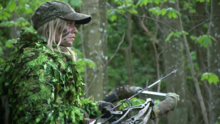Hunting Law (Denmark)

The objective hunting law (Danish: Jagtret ) in Denmark includes all legal norms that deal with hunting in Denmark. The corresponding regulations are mainly bundled in the Jagtlov (Hunting Act).
Law
The right to hunt is inextricably linked with land ownership . Only the owner and his relatives have the right to hunt on contiguous property of at least 1 hectare . Hunting is not permitted on smaller areas. From 5 hectares of contiguous property, the owner can contractually transfer the hunting rights to third parties for a maximum of 30 years. If it has been agreed for areas under 5 hectares that they will be hunted together with adjacent areas and the resulting huntable total area is at least 5 hectares, the right to hunt for the total area can be contractually transferred to third parties.
In order to be allowed to hunt, a hunting license must be obtained every year , the first issue of which requires one or more hunting tests, depending on the hunting weapon used ( shotgun , rifle and bow ). The annual hunting license includes hunting liability insurance that covers damage to third parties. A minimum age of 16 years is required for admission to the hunting tests and thus also for the issue of a hunting license. Hunting license holders under 18 years of age must be accompanied by a hunting license holder who is over 18 years old when hunting.
When hunting, keep a distance of at least 50 meters from residential buildings, unless you first obtain the owner's written permission. In Denmark, as in many other European countries including Germany, the game itself is regarded as res nullius, i.e. ownerless. Only when it is appropriated by the hunter does it become human property. When Wild was wounded or at least suspected, must be one of free active, registered bloodhound be notified eführer, the Authority has injured wild without prior notification in foreign hunting grounds to pursue it to death.
Key figures
As of 2010 there are 172,000 hunting license holders in Denmark, which corresponds to a share of 3.4% of the total population with a total of 5.4 million inhabitants. Statistically, there are 4 hunting license holders for every 100 hectares or 1 km² of land. Around 37% of Danish hunters are between 21 and 39 years old and around 4% are women. The annual turnover generated by hunting is estimated at 400 to 530 million euros. A Danish annual hunting license costs around 70 euros. The Danmarks Jægerforbund (Danish Hunting Association) with around 93,000 members and 900 local associations acts as a lobby group and is involved in the state wildlife management .
literature
- FACE - European Federation for Hunting and Conservation (Ed.): Hunting in Denmark. 2008, face.eu ( archive link ).
- Rory Putman, Marco Apollonio, Reidar Andersen (Eds.): Ungulate Management in Europe: Problems and Practices . Cambridge University Press, 2011, ISBN 978-0-521-76059-1 .
- Reidar Andersen, Vidar Holth: Ungulates and their management in Denmark . In: Marco Apollonio, Reidar Andersen, Rory Putman (eds.): European ungulates and their management in the 21st century . Cambridge University Press, 2010, ISBN 978-0-521-76061-4 .
Web links
- retsinformation.dk: Jagtlov - Lov om hagt og vildtforvaltning (Danish Hunting Act)
- naturstyrelsen.dk: Jagt & regulering (official website of the Danish nature authority)
Individual evidence
- ↑ hunted In: sproget.dk. Retrieved January 30, 2019 (Danish).
- ↑ a b c d e f Jørgen Primdahl, Mikkel Bojesen, Jens Peter Vesterager, Lone Søderkvist Kristensen: Hunting and Landscape in Denmark: Farmers' Management of Hunting Rights and Landscape Changes . In: Landscape Research . tape 37 , no. 6 , December 2012, ISSN 1469-9710 , p. 659-672 , doi : 10.1080 / 01426397.2012.728577 .
- ↑ a b c Andersen (2011), Ungulates and their management in Denmark. P. 77 f.
- ↑ a b c d e f Andersen (2011), Ungulates and their management in Denmark. P. 77
- ↑ Andersen (2011), Ungulates and their management in Denmark. P. 78
- ↑ Andersen (2011), Ungulates and their management in Denmark. P. 78 f.
- ↑ Andersen (2011), Ungulates and their management in Denmark. P. 79
